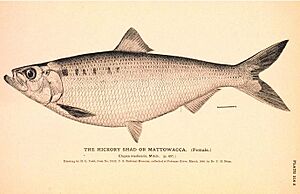Hickory shad facts for kids
Quick facts for kids Alosa mediocris |
|
|---|---|
 |
|
| Conservation status | |
| Scientific classification | |
| Synonyms | |
|
Clupea mediocris (Mitchill, 1814) |
The hickory shad (Alosa mediocris) is a cool fish that lives along the East Coast of the United States. You can find it from Florida all the way up to the Gulf of Maine. It's also known by other names like fall herring or bonejack.
This fish is special because it's an anadromous species. This means it spends most of its life in the ocean. But, it travels into freshwater rivers to lay its eggs. Hickory shad are part of the Alosidae family, which includes other types of shad and herring. People enjoy fishing for them, but sometimes they get mixed up with American shad in fishing records.
Contents
What Does a Hickory Shad Look Like?
Hickory shad are long and flat fish, kind of like a pancake but thicker in the middle. Their scales on the belly feel a bit rough, like a saw. The top of the fish is a green-gray color. Their sides are shiny silver, and their belly is white.
You might notice small dark marks on their scales. They also have a dark spot near their shoulder, often followed by a few lighter spots. A good way to tell a hickory shad apart from an American shad is to look at its lower jaw. In a hickory shad, the lower jaw sticks out past its nose.
Where Do Hickory Shad Live and How Do They Grow?
Hickory shad live along the coast from northern Florida up to the Gulf of Maine. The biggest groups of these fish are found in Chesapeake Bay and along the coast of North Carolina.
They are schooling fish, meaning they swim together in large groups. They live in the ocean, usually not too far from land. Adult hickory shad swim into estuaries (where rivers meet the sea) and freshwater rivers in the spring to lay their eggs.
Hickory Shad Life Cycle and Reproduction
Hickory shad lay their eggs from December to June. It starts earliest in Florida and later in the northern areas. Their eggs are tiny, about 1 millimeter wide, and a bit sticky. They are spread out over gravel bars in rivers where the water flows at a medium speed.
After the eggs absorb water, they become somewhat floaty. They then drift along the bottom of the river as they develop. A single female can lay a lot of eggs, from about 43,000 to 475,000! We know what the eggs, young fish (larvae), and juvenile fish look like. However, scientists are still learning about where these young fish live and how fast they grow.
Hickory shad can live for up to seven years. Both male and female fish start to have babies when they are about 2 years old. They can also lay eggs multiple times in their lives. Female hickory shad are usually bigger than males. For example, in Florida, females are about 37 centimeters (14.5 inches) long, while males are about 34 centimeters (13.4 inches) long.
What Do Hickory Shad Eat?
Hickory shad are piscivores, which means they mostly eat other small fish. But they also eat crustaceans (like crabs and shrimp) and squid. One study in Florida showed that when they are in the rivers to lay eggs, almost all of their diet is fish. However, they don't eat much during their trip to freshwater. Instead, they use up the fat they stored before their journey.
Hickory Shad and People
Recreational Fishing for Hickory Shad
Hickory shad don't have a very high value for commercial fishing. But, catching them for fun has become very popular, especially in the mid-Atlantic states. By the late 1980s and early 1990s, articles about hickory shad started appearing in sport-fishing magazines.
Headlines would say things like "the tough fighting hickory shad swarm near the rock-studded fall line…" These articles helped people learn how exciting it was to fish for hickory shad. Later, special magazines and sports sections in newspapers also started talking about how fun it was and how the fish populations were getting healthier.
In a survey done in North Carolina (2004-2005), hickory shad became the fourth most popular fish for coastal anglers. This is amazing because they are only present for two months of the year! People also catch hickory shad to use them as bait for bigger fish.



